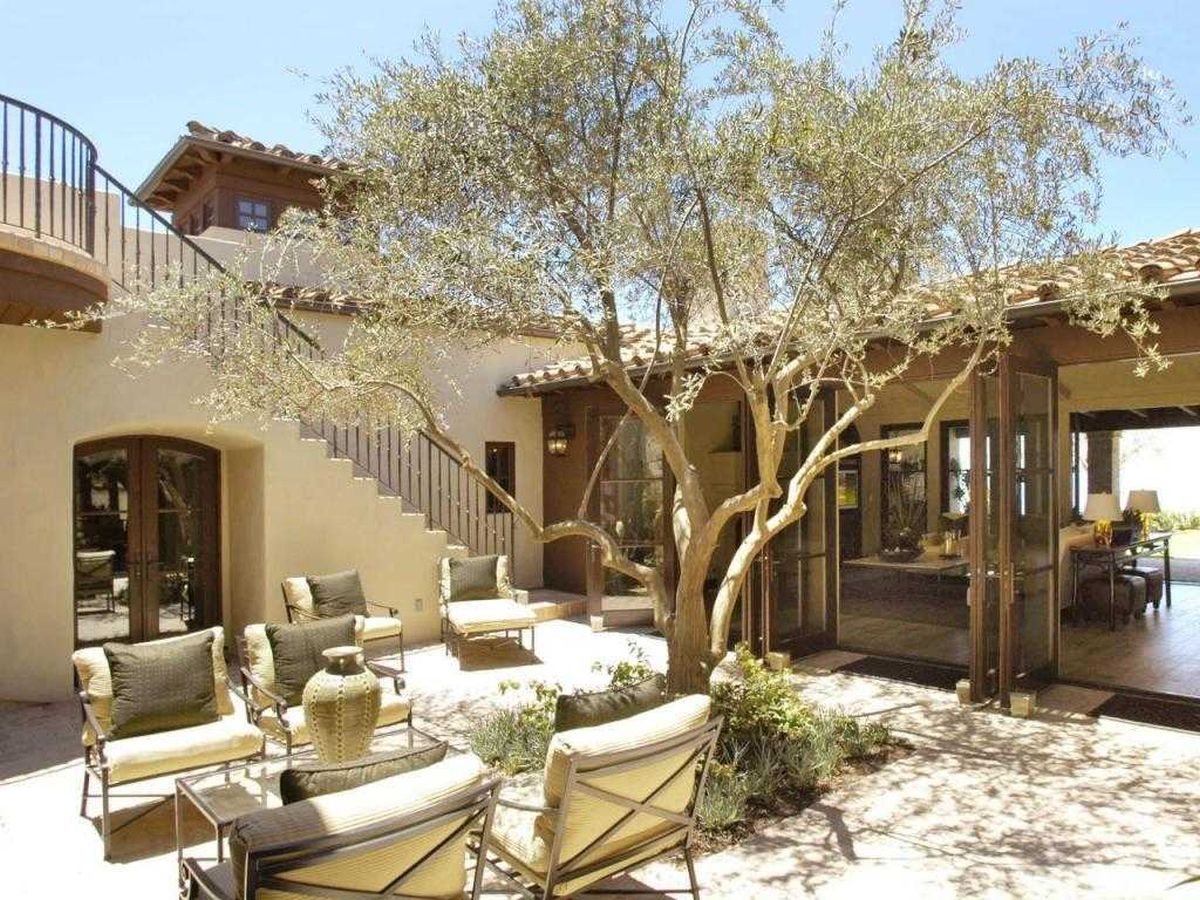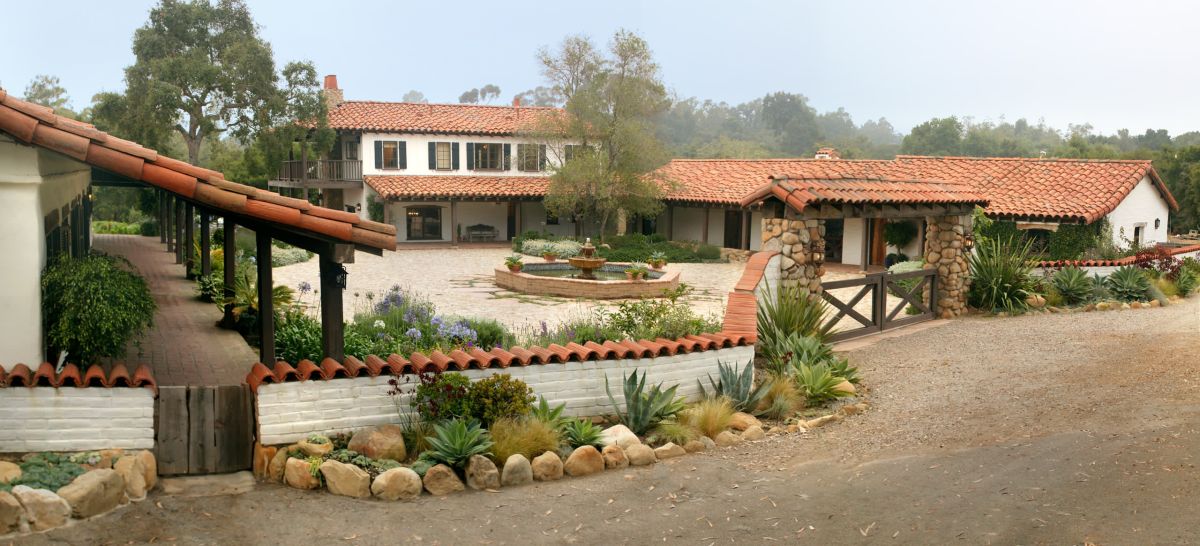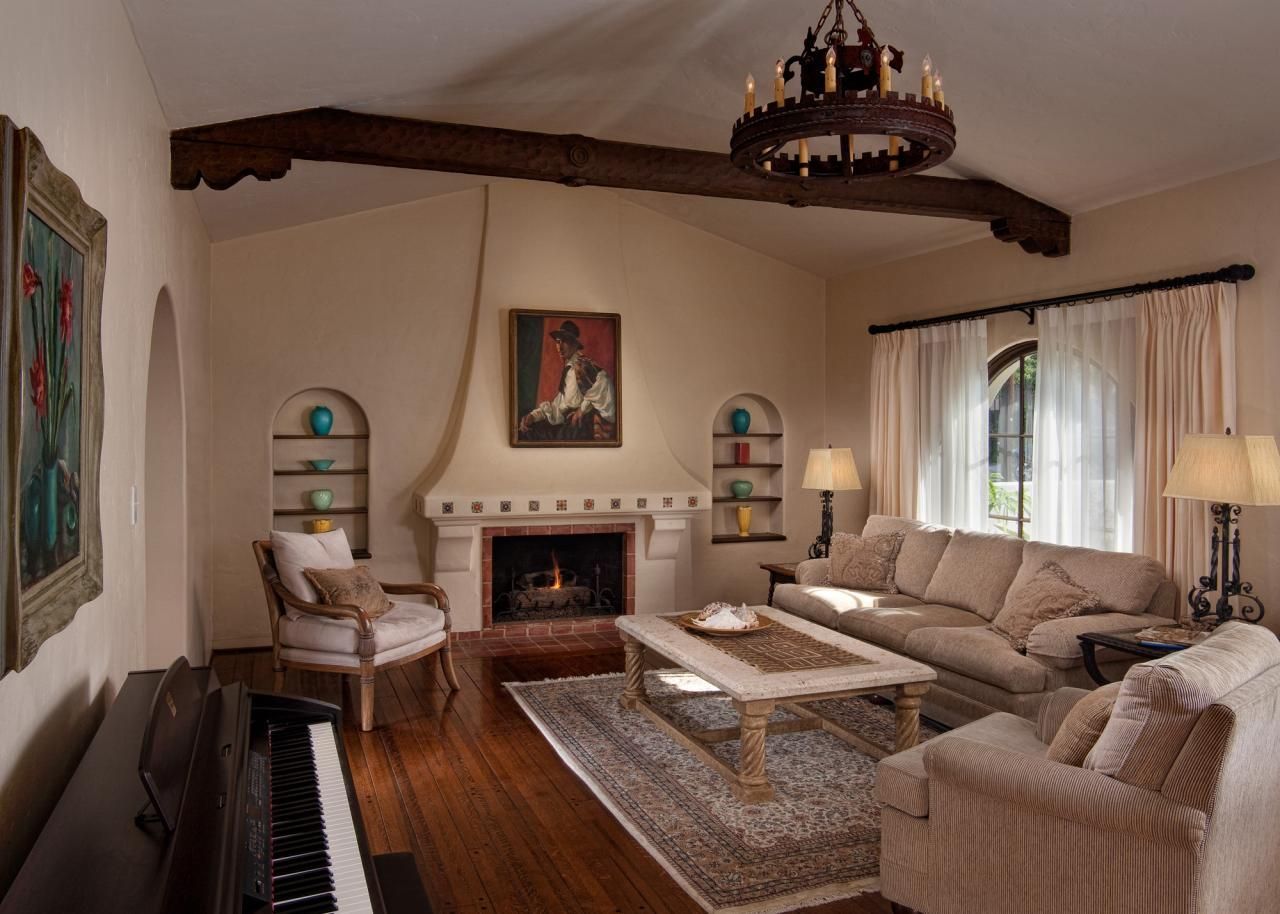Spanish-style homes are literally a product of their environment. When you live in an extreme climate, every decision you make is based on one thing: survival. Consequently, Spanish architecture is ideal for hot, dry weather, built with locally available materials in desert areas: stone, dirt and clay,

You’ll find Spanish-style houses in hot climates with cacti in the gardens and sun-warmed tiles on the roof. Spanish architecture has other important characteristics too.
Here’s everything you need to know about Spanish-style homes that might just convince you to move to the desert.
History of Spanish Decor
Spanish architecture was first seen in America in 1915 at the Panama-California Exposition in San Diego. Architect Bertram Goodhue designed a structure he called the California Quadrangle in Balboa Park.
This example of white stucco walls and red tile roofs went wild in the American West. Architects began constructing Spanish-style homes with these features all the way through the 50s. This launched the popularity of Spanish architecture.
The majority of Spanish homes found today are a blend of styles. While maintaining the classic stucco exterior walls and red tile roofs, you might find a Mission-style bell tower or a Monterey style second floor balcony. Since Spanish architecture features are ever evolving, it’s easier to lump it under the Spanish-style label because that’s what it’s become. With all the different examples of Spanish-style homes, the options are limitless, making it a great opportunity for home builders.
Exteriors of Spanish style homes
Stucco walls
One of the first things you might notice about a Spanish-style home is the white walls. White stucco is a prime choice because the color reflects the sun instead of retaining its heat. This is a good, practical choice for a desert home.
Tiled roofs
The second biggest defining feature of Spanish-style homes is red-tiled roofs. Clay is easy to come by in desert areas so it makes sense to use the material for your home. Not to mention, it provides the major detail for the exterior of a Spanish-style house.
Next, we start finding variances in Spanish-style houses. While stucco always has some role on the exterior of a Spanish-style home, you might also find stone or brick as well. Usually, it creates a visual feature rather than a functional feature.
Patterned tile
When the majority of your home is flat and plain, you have to have an eye for details. In Spanish home, you might find that piece in a patterned tile accent.
Maybe it’s on the steps leading to your front door or maybe it’s your front porch area. That bright color will give your Spanish-style home the pop you’re looking for.
Brick or stone
While you have plenty of pattern above your head on the roof, why not add some underneath your feet? Rather than a concrete or asphalt driveway, consider using brick or stone to give your Spanish-style home that luxe feeling.
Most all classic Spanish-style homes are asymmetrical in design. If you have a grand front door, maybe in a tower like the one above, embrace the silhouette. Make it stand out with patterned tiles or landscaping or whatever you need to do to play up the Spanish architecture.{found on jaureguiarchitect}.
Colorful accents
Looking for a little more color for your Spanish-style home? Time to grab the paintbrush. Choose a bright shade that matches any patterned tile you might have and paint your window sashes.
You’ll be surprised at how much just a little paint will affect your Spanish-style house.{found on rddavisarchitect}.
Wrought iron
Sometimes the front yard of a Spanish home will be a courtyard of sorts with a gate and all. If that describes your Spanish-style home, definitely seize the opportunity and find a spectacular gate.
Heavy iron is preferable and any pattern will do for a Spanish-style house.
Landscaping
Lawn care isn’t easy when you don’t have the funds to pay someone else to do it. Rather than mowing and weeding, cover your front yard in landscaping. The hot dry climate means nothing will get too tall or look too wild. This type of outdoor space is ideal for Spanish-style homes.
Sheltered outdoor spaces
When you live in an area with snakes and coyotes and large bugs, it’s obvious that you might prefer a sheltered outdoor space to enjoy. If a Spanish-style home is big enough, it might just feature a courtyard instead of a backyard. Covered in tile, it’s the perfect place for outdoor lounging and potted plants.
Want to give your courtyard a little more interest than just potted plants and a few chairs? A pergola with an outdoor fireplace are the perfect complements for Spanish-style homes. These make a lovely seating area and give you the opportunity to add more stucco to your Spanish-style home.
Outdoor seating nooks are always a fun feature in a yard. Make a bench look built into your Spanish-style home to create a little spot to hide away from it all in your corner of your interior courtyard.
Everyone who has designed a home of their own knows the value of separate areas for separate purposes.
Turn some of the space in your Spanish-style house into patio space. This lets you feature an outdoor dining room and an outdoor living room, both separate from each other and your pool.
Do you have kids in your Spanish home? Then a courtyard covered in patio pavers might not be the best option. Give them some grass to play on and they’ll love you forever. Get ready for outdoor bonfires and movie nights on the lawn of your Spanish-style house.{found on mainedesign}.
Are you looking for a way to modernize your Spanish-style house without losing its originality? Think industrial. With iron-rimmed windows and linear features, you’ll bring those Spanish elements to an updated beauty.{found on vanguardstudio}.
Spanish-style house interiors
Indoor stucco
It’s not surprising to find many exterior features of Spanish-style homes on the inside as well. Some rooms might have stucco walls instead of drywall. This provides plenty of texture and interest on which to build your decorating. It makes a great base to which you can add all kinds of decor and a Spanish eclectic interior.
Stone
Like the exterior, stucco might not be the only thing you’ll find on the walls. Stone makes a great accent in rustic homes and you’ll find it goes perfectly in Spanish-style homes too. Light shades and earthy tones will match your stucco walls perfectly.{found on bjdhausdesign}.
High ceilings
While many Spanish-style houses are standard height, there are a few that feature high ceilings.
Stick with simplicity as you decorate. Don’t let all that wall space go to your head so your eyes will be drawn to the things that matter.{found on markweaver}.
Exposed beams
When you have the taller height of the ceiling, you can’t help but include some exposed beams, common in Spanish architectural style.
Whether you want raw, rustic beams or smooth and stained versions, this major detail will pull together all your wood furniture. Wooden beams are ideal for unifying a Spanish eclectic room.
Fireplace
Of course, it isn’t hot all year round, which is why many homes in the Spanish style have a grand fireplace. It might have a chunky mantle or maybe it goes all the way to the ceiling but either way, make that the focal point in your living space.
Let’s talk about lighting. You may have already noticed that much of the lighting in a Spanish home is wrought iron. Something heavy and dark will stand out against the light stucco and hold its own against the dark wood decorative elements.
Wooden furniture
Can we talk about Spanish furniture? As you plan the furniture for your Spanish-style interior, you definitely want to look for wood pieces.
Heavy dark accent tables, high headboards, deep rich wood tones will fill your space with Spanish style. The wood pairs well with the earthy tones you’ll find in this style.
Not only should furniture be wooden and heavy, you’ll get a design boost if it’s intricately carved as well. This is a nod to the Spanish Baroque design era.
This Spanish style fits perfectly in your smooth stucco-filled home. In fact, when it comes to Spanish baroque, the more detail the better.
Wood cabinetry
Furniture isn’t the only place you can add some heavily carved wood. If you’re considering a kitchen makeover, find cabinets that fit that heavy wood description. You’ll get design bonus points if it has carved detail like the rest of your furniture. Wood cabinetry fits well into a Spanish eclectic kitchen too. {found on housebeautiful}.
Rich color
Wood pieces aren’t the only type of decor that you’ll find in Spanish-inspired homes. Spanish decor is not afraid to embrace rich jewel shades. Bright red and blue, golden yellow and orange — all colors you’ll find Spanish-style homes have because they fit so well, especially in Spanish eclectic style.
Speaking of pattern, you’ll be happy to know that when it comes to patterned tile, your modern Spanish home is your canvas.
Give your kitchen a big statement with a patterned backsplash. Cover your shower in your favorite design. It’s an opportunity to make your home have even more Spanish style.
Substantial window coverings
Last but certainly not least, you want to give your window coverings some real thought when it comes to Spanish style. Typically, these homes had small windows, but today’s layouts feature larger one.
It’s likely that you have the hot sun coming into a living area in the afternoon so you’ll want heavy curtains that you can close to help keep your space cool. Make sure that they’re hung high and wide to get the most out of your windows. This is especially true if you have large, arched windows.
There are some truly impressive homes in the Spanish style as well as Spanish-style mansion options. They definitely do this style justice so let’s have a closer look at a few of them.
Spanish Style Houses
A Spanish colonial home in Southern California
This gorgeous house sits on 1.7 acres of beautiful land in Los Angeles, California. Studios OZ Architects and The JRC Group collaborated on this example of Spanish colonial architecture.
It’s definitely a big Spanish-style mansion with more than 20,000 square feet of living space. It has 7 bedrooms and 9.5 bathrooms is a design that’s rooted in 1920s Spanish Colonial style homes. There’s a central courtyard and plenty of cool features inside.




Given its size, you’d expect the interior to be opulent and luxurious. In a way it is, but it’s also elegant, refined and very inviting. Some areas are quite impressive, like the master suite which measures 2,500 square feet. It has two bathrooms and large closets. There’s also a massive wine cellar decorated with stone which can hold 7,000 bottles. It also has its own tennis court, a spa and, of course, a swimming pool.
A Spanish revival home in Sonoma
The beautiful Sonoma region in California is known for its magnificent estates and its historic value. Robert Baumann + Associates designed this Spanish-style mansion. The owners wanted it to reflect their own style. They had an inclination toward Spanish revival architecture so they decided to go with it.
The site was previously occupied by an old house that the new owners had no interest in preserving. They took it down and built the new and slightly bigger Spanish revival house in its place. However, they did, make sure to preserve as much of the beautiful landscape and trees as possible.
There’s now a lovely 3,600 square-foot house here with a big basement and large outdoor terraces and patios. The design uses mainly traditional and natural materials like stone and wood with iron accents, typical in Spanish revival homes. and this gives the house a really authentic look.
Frequently Asked Questions (FAQ)FAQ
What makes a Spanish-style home?
Spanish-style architecture, found mostly in the western and southwestern parts of the United States, have feaatures that fits warm climates. The key element of this style is white stucco walls but red tile on the roof and wrought iron accents are also among the common features.
What is a Mediterranean-style house?
Mediterranean-style houses vary because they incorporate different architectural influences. At the same time, they have a number of traditional elements in common. These typically include a low-pitched roof, arched doorways, arched windows, bell towers, wooden support beams and lots of natural elements.
What's the difference between Spanish Colonial and Spanish Revival?
While Spanish Revival style is influenced by the Spanish Colonial period, it features decor elements that are more ornate. Usually, this takes the form of intricate patterns in tilework and fancy wrought iron elements.
Are Spanish-style homes more expensive?
Some of the same elements that distinguish a Spanish-style house also make it more expensive to build. Mainly the higher cost comes from the tiled roof, which costs about three times the price of a regular roof with shingles.
What is Mission Revival-style architecture?
Mission revival homes draw inspiration from the Spanish missions that were built in California in the late 18th century. Spanish settlers brought the features of traditional Spanish homes to the US which designed picked up. This is sometimes called California Mission Revival, especially when used in other regions of the southwestern US.
What are the elements of Spanish Colonial architecture?
This Spanish style grew out of the era of Spanish Colonialism. These homes use local materials, natural elements and have exterior walls that are thick and covered with stucco. Some may have adobe walls, especially Pueblo revival homes that are typical of the New Mexico area.
Many Spanish colonial homes are one story. They typically have small windows, a flat roof, wooden support beams and an inner courtyard.
What is Santa Fe style called?
Actually, Santa Fe Style is also called Pueblo style, Pueblo revival and Adobe Revival. These homes reflect the style of the Spanish Colonial West, combined with Spanish style. These homes incorporate styles from the Pueblo and Hopi Native American tribes.
Conclusions
Spanish-style homes have great variety and are found across the south and west of the United states for good reason. The architecture has features that are ideal for living in hot, dry climates. Of course, the same iconic elements of this style also make it inappropriate for climates that are cold. If the climate is right, you can have a marvelously stylish Spanish home withall the modern elements you want.
The post Spanish Style Homes Are Ideal for Hot, Dry Climates appeared first on Home Decorating Trends - Homedit.







































0 Commentaires